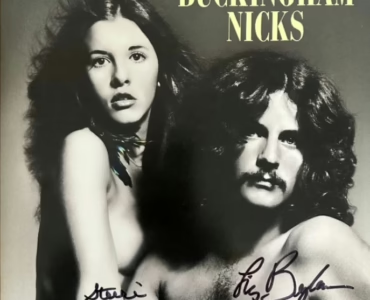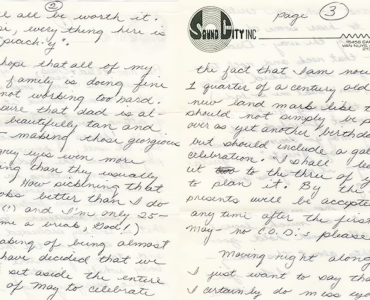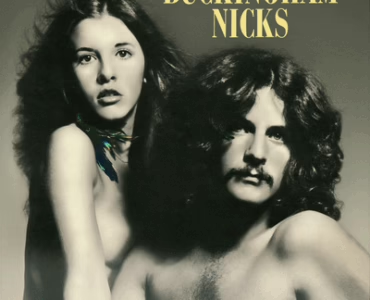Stevie Nicks and Lindsey Buckingham made a fine pop record pre-Fleetwood Mac.
Permanent Records is an ongoing closer look at the records that matter most.
Anyone who’s ever flipped through the dollar bin at a used vinyl store is familiar with the kind of old LPs that land there. Christmas albums. Children’s sing-alongs. Weird spoken-word rants. Campy celebrity vanity projects. K-Tel collections galore. And, occasionally, a record that looks like it could be big-time, even though the artist is unfamiliar. Maybe the cover art looks polished, or maybe it came out on a major label. Whatever the reason, the very existence of the album stops the shopper for a few seconds, and raise questions. Why’d these artists get signed? Why didn’t they have any hits? Does the music sound like a more generic version of everything else that was on the charts at the time, or did it flop because it was too original?
 Take this one, for example:
Take this one, for example:
This was a Polydor release, so the attractive, bare-chested, ultra-1970s pair on the front probably received a decent amount of money to sign their contract and cut the record. And while it’s hard to tell from their look what the group’s sound is (singer-songwriter folk? shaggy glam? Hall & Oates-style blue-eyed soul?), they’re certainly both pretty enough to be marketable. Nevertheless, Buckingham Nicks sold poorly, generated no hit singles, and was quickly dumped into the remainder racks, forcing the duo to take day jobs while they contemplated whether they should continue to pursue careers in the music business. In the original edition of The Rolling Stone Record Guide, critic John Milward gives the album two stars out of five, and dismisses it as, “pleasant, albeit middleweight Los Angeles folk-rock.”
Milward was being ungenerous—but he’s not entirely wrong. Buckingham Nicks is only 35 minutes long, and about a third of its tracks feel like filler. The second song, “Stephanie,” is a pretty-but-slight acoustic guitar exercise, as is the one-minute “Django” on side two. “Lola (My Love)” is a dreary, unconvincing stab at swampy blues-rock; and while the uptempo guitar-pop ditty “Without A Leg To Stand On” is one of the LP’s best tracks, it’s over and done in just two minutes. On a longer album, all of these songs might fit into a bigger picture. But there’s no grand design to Buckingham Nicks. It does build to an impressive, semi-epic closer, “Frozen Love,” but for the most part this record is a showcase for four potential chart-toppers: “Crying In The Night,” “Don’t Let Me Down Again,” “Long Distance Winner,” and “Crystal.”
 But even if Lindsey Buckingham and Stevie Nicks hadn’t gone to multiplatinum success with Fleetwood Mac just two years later, any fan of mid-1970s west-coast pop should’ve been able to recognize the excellence of those four key Buckingham Nicks songs. “Crying In The Night” kicks off the album with soaring harmonies, an appealingly chunky beat, and an overall style that’s just a little too dry to qualify as country-rock. “Don’t Let Me Down Again” starts side two with driving rhythms and a choogling guitar line that transforms Buckingham’s virtuosity into stormy rock ’n’ roll. “Long Distance Winner” is a solid early example of the witchy atmospherics that would soon become Nicks’ stock-in-trade. And “Crystal” brings it all together, following a winding line that allows the guitar, the vocals, and producer Keith Olsen’s clean sound all to shine.
But even if Lindsey Buckingham and Stevie Nicks hadn’t gone to multiplatinum success with Fleetwood Mac just two years later, any fan of mid-1970s west-coast pop should’ve been able to recognize the excellence of those four key Buckingham Nicks songs. “Crying In The Night” kicks off the album with soaring harmonies, an appealingly chunky beat, and an overall style that’s just a little too dry to qualify as country-rock. “Don’t Let Me Down Again” starts side two with driving rhythms and a choogling guitar line that transforms Buckingham’s virtuosity into stormy rock ’n’ roll. “Long Distance Winner” is a solid early example of the witchy atmospherics that would soon become Nicks’ stock-in-trade. And “Crystal” brings it all together, following a winding line that allows the guitar, the vocals, and producer Keith Olsen’s clean sound all to shine.
In the RSRG review, Milward writes, “Stevie Nicks and Lindsay Buckingham present narcotic voice and guitar respectively, although only ‘Crystal’ gives a hint of what would galvanize when they joined Fleetwood Mac and made two of the best-selling LPs of the Seventies.” Fleetwood Mac re-recorded the song for its self-titled 1975 release, which was the first album to feature Buckingham and Nicks, and the one that resuscitated the fortunes of all concerned.
When Rolling Stone first reported on the addition of Buckingham and Nicks to Fleetwood Mac, the magazine didn’t have much to say about the new members’ major label past, and instead focused mainly on whether the band could weather the departure of popular singer-songwriter-guitarist Bob Welch (the man responsible for the few Fleetwood Mac songs that were still getting radio play at the time). Elliot Kahn’s article reads:
Welch’s departure was just one more in a long line of setbacks to overcome. Within two months of his leaving they were in the studio with two new members, guitarist Lindsey Buckingham and vocalist Stephanie (Stevie) Nicks, recording a new album called Fleetwood Mac, which shows signs of being their most successful effort since the release of Bare Trees three years ago. Mick Fleetwood actually heard a tape of their Polydor album, Buckingham Nicks, the week before Welch quit; when there was an opening, he thought of them and played their record for John and Christine McVie and they all invited Lindsey and Stevie to join the band without ever having played with them onstage. … At the time Lindsey and Stevie were languishing in Los Angeles, having been dropped by Polydor after the poor sales of their album. They were in the midst of recording a demonstration tape when the offer from Fleetwood Mac came out of nowhere. Lindsey intimated that their acceptance of the offer was surprisingly less than automatic. “We were really excited about our tapes, and I wasn’t so thrilled about what Fleetwood Mac had done in the years with Bob Welch. But then we thought about the benefits and said, ‘Of course.’ I think it’s working out well for all of us.”
 That last line is what’s called “an understatement.” Fleetwood Mac was a monster success. The follow-up, 1977’s Rumours, was even bigger. And then the divisive masterpiece Tusk in 1979 revealed the extent of Buckingham’s mad genius as a producer and guitarist. (If nothing else, Tusk is the kind of album where a song like “Django” would’ve fit right in, seamlessly.)
That last line is what’s called “an understatement.” Fleetwood Mac was a monster success. The follow-up, 1977’s Rumours, was even bigger. And then the divisive masterpiece Tusk in 1979 revealed the extent of Buckingham’s mad genius as a producer and guitarist. (If nothing else, Tusk is the kind of album where a song like “Django” would’ve fit right in, seamlessly.)
It’s because of the Fleetwood Mac connection that Buckingham Nicks won’t be found in any dollar bins. (Unless they’re being stocked by some clueless clerk, that is. There’s nothing vinyl collectors love more than vendors who don’t know what the value of what they’re selling.) A quick scroll through eBay shows vinyl copies going from $50 to $100, generally. But given how popular all things Fleetwood Mac-related are—especially among people who grew up in the 1970s and 1980s— it’s odd that Buckingham Nicks isn’t talked about more, or held in higher esteem. Odd, but not inexplicable. Fleetwood Mac fans do know about Buckingham Nicks. The problem is that a majority of them have never heard it.
Some rare albums are hard to hear because there’s not enough of a market for a reissue, while others get tangled up for contractual reasons. But no one can seem to explain why Buckingham Nicks has never (legally) been released on CD, and isn’t (legally) available to download. There’s definitely a demand for it, and no apparent concerns about who owns the rights to the music. As recently as 2012, in an interview with Andy Greene for Rolling Stone, Buckingham and Nicks both expressed an interest in re-releasing the record, perhaps for its 40th anniversary in 2013. But this never happened, and again, the reasons are vague.
Buckingham and Nicks apparently consider their debut album to be a part of their musical legacy. Along with “Crystal,” Fleetwood Mac used to play “Frozen Love” and “Don’t Let Me Down Again” in concert, and even included the latter on its 1980 live album. Nicks has kept “Long Distance Winner” in her repertoire, while Buckingham has included “Stephanie” in his solo sets.
But in that 2012 Rolling Stone article, both seem to treat a reissue as a complicated ordeal that may not be worth their time. Nicks talked about polishing up some bonus tracks and then hitting the road with the old band—which would include in-demand session-player Waddy Wachtel. Buckingham couldn’t figure out how to fit archive-digging, remastering, and promotion into their already busy schedules of making solo records and gigging with Fleetwood Mac. And so… nothing.
For what it’s worth, there’s already a very nice “deluxe edition” of Buckingham Nicks available on-line, for free—found with minimal Googling. In addition to a crisp-sounding version of the original album, the set adds the single edits of “Don’t Let Me Down Again” and “Crying In The Night,” plus some songs that didn’t make it onto the record (including an early take on “Sorcerer,” which Nicks would revive decades later for one of her solo albums) and a few live performances (including the first time Nicks sang “Rhiannon” in public, pre-Mac).
The point being: It’s probably not as difficult as Buckingham or Nicks seem to think to reissue the album. It would just require them to agree to do it, without thinking about the project as some kind of major corporate launch. A tour would be nice, but inessential. If there’s more bonus material to add than has already leaked on-line, great, but the fake “deluxe” version is amply stocked as it is. Theoretically, the duo could start selling the record on iTunes tomorrow, if they really wanted to. But maybe after spending 40 years as two of the richest, most famous, most beloved rockers of their generation, it’s hard to go back to thinking small.
That’s what’s so fascinating about the major-label also-rans and never-weres that turn up in the dollar bin. Each represents a story that’s mostly gone untold, except to those who knew band personally. It’s a story about getting seduced by the money and promises of the recording industry, then enduring compromises and humiliations while trying to produce something commercial enough to justify the label’s expenses. Buckingham and Nicks came out of the other side of that combine okay. But if Mick Fleetwood had never picked up the phone, who knows? All they might’ve had to show for their years as professional musicians is one half-realized LP, brimming with a promise only recognized by those willing to pony up a buck.
Noel Murray / AV Club / 29th September 2015





